Bumped from Endeavour Flight, Madly Powerful British Supermagnet Looks for Work Elsewhere
It could bend harmful radiation away from astronauts, or focus plasma for a novel propulsion engine

When Endeavour took off for the International Space Station on Monday, it took with it the $2 billion Alpha Magnetic Spectrometer (AMS), the largest space instrument ever launched into orbit that will study high-energy cosmic rays incoming from faraway parts of the universe. But Endeavour also left something behind on Monday: an extremely strong super-cooled magnet that was bumped from the AMS experiment last year. Now, researchers are looking for a way to put it to work.
In order for AMS to study those incoming high-energy particles, it needs to know their charges. To determine this, the experiment will rely on a very strong magnet to bend the particles–how they bend says a lot about their charge, which says a lot about where the particles came from. These kinds of magnets have to be specially designed (they are cooled with liquid helium to very low temperatures, and thus are not your average magnet), and the UK’s own Scientific Magnetics spent more than a decade developing one for the AMS.
Then, a year ago, the magnet was booted from Endeavour’s flight. When it was determined last year that the ISS’s life would be extended to 2020 researchers decided they wanted a longer-lived magnet. They opted for a less powerful option with a longer lifespan, and Scientific Magnetics’ magnet was put on the shelf.
But such a precise, high-powered magnet (shaped like a hollow cylinder, it points its entire field inward) is too rare and awesome to go to waste. There are a few potential uses for it, the BBC’s Jonathan Amos, notes, neither of which will likely see the magnet launched into space but both enabling critical future space travel technologies.
First, it could be used to study the ways a huge, hollow cylindrical magnet–one several meters in diameter–could be used to shield future astronauts from cosmic rays in space. Such a magnet would actually wrap around a habitat and project its magnetic field outward, leaving the interior magnetic field-free. But on the outside, it could deflect cosmic rays, making a future moon base or long-term deep space flight more hospitable to humans.
This technology could also help power a future deep space mission via ion propulsion. Ion propulsion engines require the crafting of finely tuned magnetic fields that can mold the shape of highly excited gases and plasmas as they are released to create thrust without combustion. In such engines, the magnets function as nozzles that optimize and control the plasma flow to provide the kind of thrust that could (theoretically) get a spacecraft to Mars in weeks rather than months.